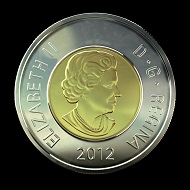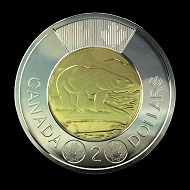March 3, 2016 — Exactly two decades ago, Canadians were introduced to a new two-dollar circulation coin which replaced banknotes of the same value. Following the successful transition to a one-dollar circulation coin in 1987, Canadians quickly warmed up to their new bi-metallic, polar bear-themed coin which they soon nicknamed the “Toonie”. Since February 19, 1996, nearly 883 million Toonies, featuring nine different reverse (or tails) designs, have entered circulation.
The Toonie of 2012. Photo: Royal Canadian Mint.
“Over the last 20 years, our two-dollar circulation coin has efficiently served Canadian commerce and given the Mint many opportunities to celebrate Canada through special commemorative designs,” said Sandra Hanington, President and CEO of the Royal Canadian Mint. “It is now time for us to shine a spotlight on the Toonie by wishing it a happy 20th birthday.”
In 1996, the two-dollar coin became Canada’s first bi-metallic coin, with the inner core and outer rim solidly bonded by a locking system patented by the Royal Canadian Mint. The core was made of a copper alloy and the ring was pure nickel until 2012, when the Mint modernized Canada’s highest-value circulation coin by changing its composition to multi-ply plated steel, while still preserving its bi-metallic appearance, and adding advanced security features to its surface. In 2013, the International Association of Currency Affairs recognized these advances in coin security as the world’s best new coin innovation.
To find out more interesting facts on Canada’s two-dollar coin, a detailed infographic can be viewed here.






